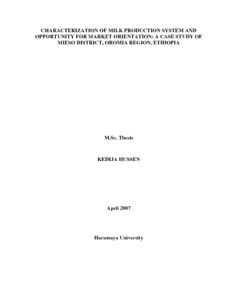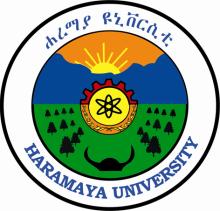Resource information
This study was conducted in Mieso district in western Hararghe Zone of Oromia Regional State to characterize milk production and marketing system and identify opportunity for market orientation. This study was initiated with the objectives of generating baseline data in the area of milk production and marketing system. The study was undertaken in five purposely selected rural kebeles of Mieso district; and these were Dire-kalu, Welda-jejeba, Hunde-misoma, Gena, and Huse-mendera. Farmers from each rural kebeles were selected using Proportional Probability to Size (PPS) approach for each rural kebele. A total of 120 farmers were selected based on the number of households. The sample households in each rural kebeles were stratified in to female and male headed households. For the market study, two market sites were purposively selected namely, Mieso and Asebot markets due to the accessibility of the area. Milk marketing was monitored over two seasons, i.e., rainy and dry seasons. The average pasture land size of the sampled households was 1 ha, with a range of 0.25-10 ha. On average, there were more number of goats (6.03 ± 0.30) holdings than cattle (5.69 ± 0.35) and camel (1.83 ± 0.92) per household. However, the average numbers of animals per species found in the studied rural kebeles was highest for goats (723), than for cattle (683) and camel (220). The proportion of female to male ratio of cattle in the district was 2.57: 1. Traditional hand milking was the major type of milking practices in the whole parts of studied area. During the study period, about 99.2 % of the households had milking cows, and 97.5 % of these households indicated that only female members of the household are responsible for milking. However, 2.5 % of the households indicate that not only females, but also males take part in milking of cows. Almost all of the households indicated that cows are milked twice during the wet season and once during the dry season. About 72 % of the respondents indicated that camels are milked up to thrice a day during the wet and dry seasons. Milk and milk product sale (96 % of the respondents) and crop sale (95 % of the respondents) take the highest percentage of source of income. All the respondents indicated that cattle, camels and goats are fed principally on communal natural pasture throughout the year. Agricultural byproducts, mainly crop residues of sorghum and maize are the major feed resources in the studied area. Traditionally, sorghum and maize plantation used as fodder for livestock feed, and it is locally called as chinki. As an additional feed, mineral soil salt, locally known as ‘‘haya’’, it is used by 40 % of the respondents during wet as well as in the dry season. All milk animals in the study area are indigenous breeds and have not been characterized. The overall mean (mean ± SE) age at first calving for cows and she camels were 52.49 ± 0.91 and 63.37 ± 1.55 months, respectively. The overall mean calving interval for cows and she camel were 16.01 ± 0.49 and 18.53 ± 1.02 months, respectively. The estimated mean milk yield/head/day was 1.24 ± 0.02 liter for cows and lactation yield per cow was 271.4 liters over an average lactation period of seven month (7.29 ± 0.17). Overall estimated mean camel milk yield/head/day was 2.4 ± 0.06 and lactation yield head was 797 liters over an average lactation period of eleven months. The estimated average total milk produced per household per day in the wet and dry seasons was 4.80 ± 0.22 and 2.37 ± 0.11 liters, respectively for cows. Similarly, the average total milk produce per household per day in the wet and dry seasons was 13.19 ± 0.945 and 7.63 ± 0.82 liters, respectively for camels. The majority of the households sale whole milk (78 %) than whey (4.2 %). Butter is produced for sell by about 67 % of the respondents. About 72% of the respondent indicated that they sale cow milk during both the dry and wet seasons. The average volume of cow and camel milk sold per household per day during the rainy season was 3.55 ± 0.28 and 3.61 ± 0.45 liters, respectively. However, during the dry season, the respective volumes decreased to 2.15 ± 0.22 and 2.58 ± 0.37 liters. Cow and camel milk supply to the market decreases by 39 % and 28 % during the dry season, respectively. This indicates that camel milk sale increases during the dry season. The amount of milk sold in Mieso market per day was significantly (P ? 0.05) higher for cow (496.6 ± 19.12 liters) as well as camel milk (187.89 ± 19.12 liters) than the Asebot market site. The price of cow and camel milk during the wet season is lower (1.88 ± 0.10 Birr/liter and 1.63 ± 0.10 Birr/liter) than during the dry season (3.38 ± 0.10 Birr/liter and 2.98 ± 0.10 Birr/liter), respectively. Generally, there are two milk marketing systems; namely, traditional milk associations or groups and the producer themselves (individual seller). The traditional milk association or group is locally known as ‘Faraqa Annanni’. From the total (n=94) households who sell milk, only 22 (23 %) were involved in the milk association or groups. An average amount of milk sale by group (3.94 ± 0.18 liter/person) were significantly (P? 0.05) higher than individual (1.64 ± 0.06 liter/person). The total amount of milk sold (liter/person/day) at the two market sites differed significantly, being higher in Mieso (3.27 ± 0.17 liters/person) than in Asebot (1.91 ± 0.06 liters/person). The number of individuals per Faraqa Annenni/day was not significantly (P > 0.05) different between Asebot (2.94 ± 0.12) and Mieso (3.05 ± 0.22). However, there was more number of seller groups in Mieso. This may be due to the involvement of pastoral milk seller groups from the adjacent district of Mullu in Somalia Region. As the logit regression result indicates the availability of Faraqa Annenni in the area had significant (P ? 0.1) positive relation with the participation decision of the household to sale cow milk. The other variable which has a significant (P ? 0.05) impact on the decision behavior of the household is its location from the market. As the model output indicates, the farther the household is away from the market center the less will be its participation to the cow milk sale. Education level of the household heads were negatively (P ? 0.05) correlated with participation decision on cow milk sale. This negative correlation of education level of the household heads with participation on cow milk sell indicates that rather than milk sale, decision on other activities were more. Contrary to the expectation, amount of goat and camel milk produced in the household were negatively and significantly (P? 0.01 and P? 0.1) related to market participation decision of the household on cow milk sale. This indicates that more production of camel and cow milk tends to shift the household consumption pattern from camel and goat milk to cow milk, which reduces the available cow milk for sale. Most of the respondents indicated that milk sale was highly affected by small milk quantity (73 %) followed by distance to market (38 %). Only 7.6 % of the respondents indicated cultural taboo as a limiting factor for milk market participation. Therefore, the figure indicating that this issue is not a serious problem in the area. Overall cattle and camel pre-weaning mortality rates were 61.7 ± 5.2 and 66.7± 14.7. Mortality due to diseases was identified as a major cause of loss in cattle (65% of respondents) and camels (67%) in the study area. Mastitis, Anthrax, pasteurolosis, diarrhea, Blackleg and FMD (Foot and Mouth Diseases) were the major diseases that affect cattle in the area. Only 33 % of the respondents indicated that they have access to extension services on dairy animal production. The farmers contact with extension staff once or twice a year and there is no strong and regular visit and follow-up. Generally, among the problems of dairy production in the area, seasonal feed and water shortage, security problem, and poor access to veterinary services were the major ones. In addition to this, low knowledge capacity and the limited number of the development agents were also reported to be common problems in the extension service. All milk animals in the study area have not been characterized. There is no any milk cooperatives organized in the area. Instead there are traditional self organized milk seller groups, Faraqa Annanni. Milk sale was highly affected by small milk quantity followed by distance to market. In addition, milk sale was also affected by non-availability of Faraqa Annanni in the area. Accordingly, improve the available natural pasture and implement rangeland management systems, introduce and develop improved forages as sole crops or integrated with cereal crop production should be made. There should due attention to the way of dealing with conflicts over use of resources in the district, conflict resolution method should be addressed and community should be a starting point for ideas to develop a strategic plan. There should be training for development agents and extension staff in the district about milk production, handling and processing techniques. It is necessary to improve animal health services through paravet training and drug supply system with close monitoring and supervision. Breed improvement should consider the multipurpose utility of local breeds, where it is feasible with improved feeding and proper management systems. Furthermore, establish milk collecting and processing unit through encouraging the already existing self organized group, ‘Faraqa Annanni’.



